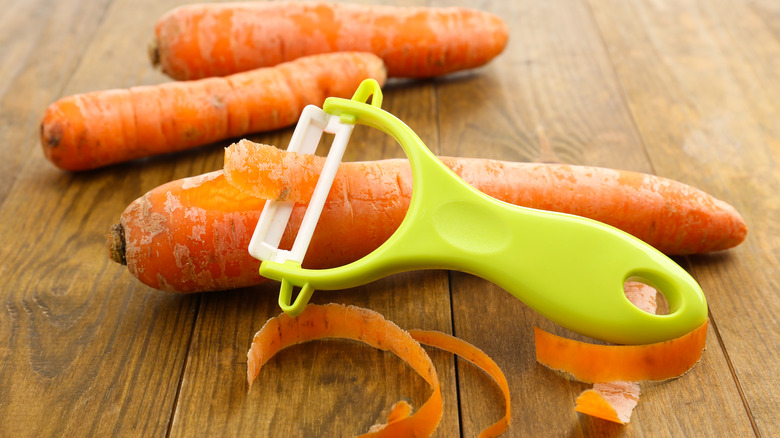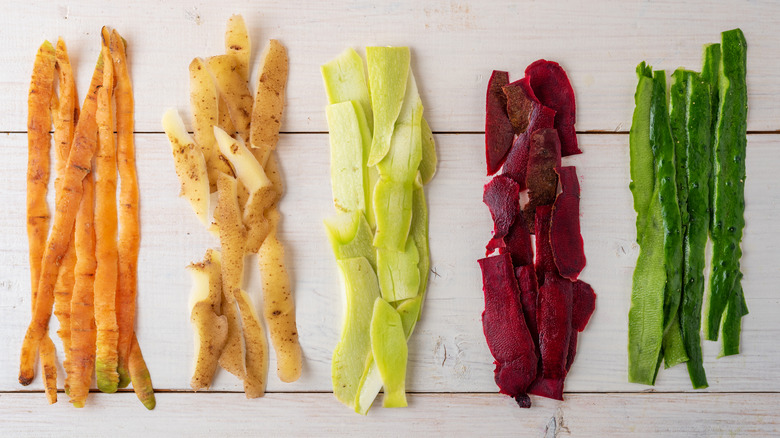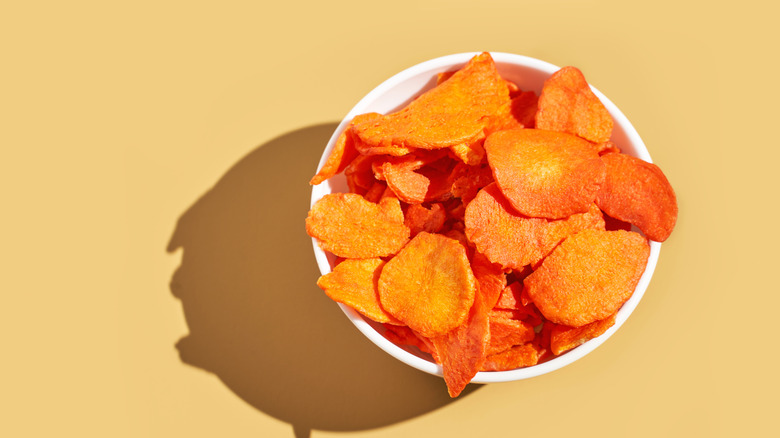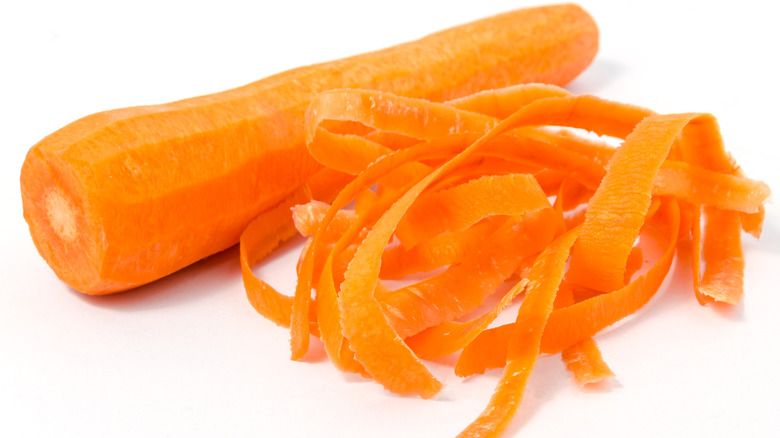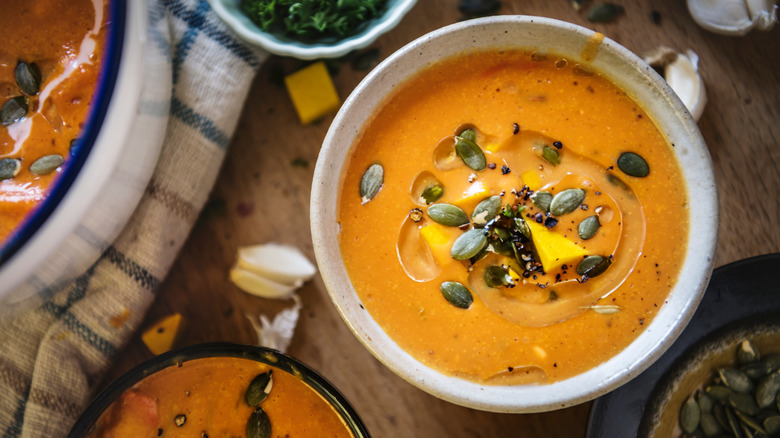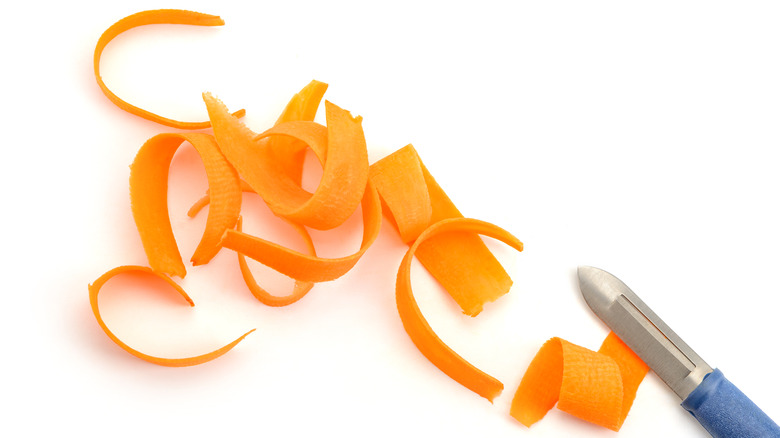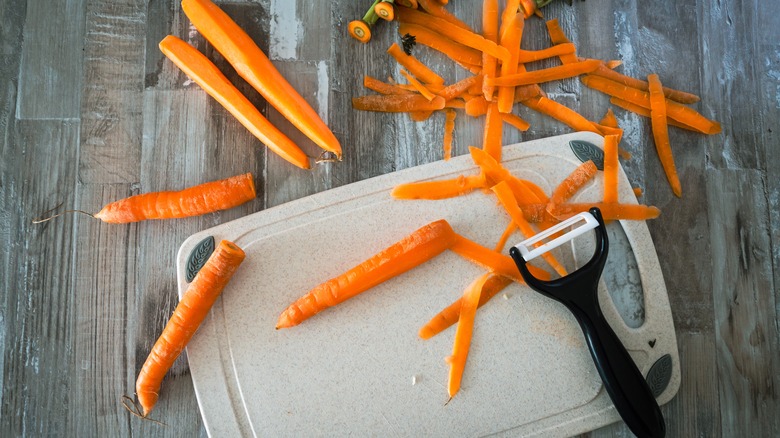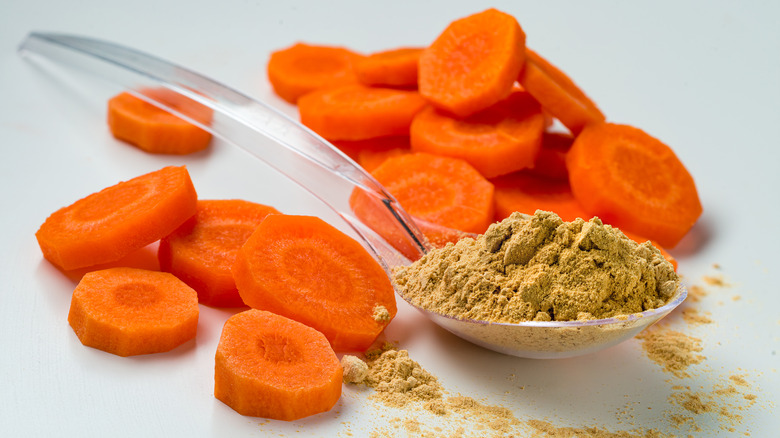The Best Ways To Use Carrot Peelings
If you're like, well, virtually everyone who's ever eaten a carrot, the next time you find yourself peeling those dirty, wrinkly skins into the trash, stop for a second and consider the following.
Carrot peels are perfectly edible. In fact, they're quite nutritious. Per Healthline, not only is it safe to eat carrot peels, but vegetables such as carrots often contain one-third more fiber when they're used unpeeled. Research conducted by Tufts University also found that vitamin C and B3 are more concentrated in the skin of the carrot than they are in the flesh.
But wait! We're not saying you shouldn't remove carrot skins while preparing them to eat. After all, Cook's Illustrated found that those scruffy skins tend to impart a bitter taste and an unpleasant earthy flavor. What we are saying is that considering the fiber and nutrients that carrot peels contain, there's a good reason to incorporate nifty ways to put them to use. You can add the peels to soups and broths, turn them into chips, and much, much more.
Homemade stock
One of the best and most obvious ways to use carrot peels — or any vegetable peels, for that matter — is to turn them into homemade stock. Really, it requires no creative flair. Plus, you'll also have stock on hand for all sorts of fancy stews, soups, braises, and sauces.
Per Serious Eats, you can save your carrot peelings (as well as its root and tips) along with other vegetable scraps in your freezer until you have a substantial amount to make a stock with. Once you're ready, just boil the peelings and scraps in water and let it simmer for 10 minutes, Serious Eats suggests. Strain out the scraps, and there you have it: homemade vegetable stock. Plus, it will be less salty and cheaper than most store-bought options whilst putting to use nutrient-packed parts of vegetables that you would otherwise throw away.
Baked chips
Seasoning your carrot peelings with spices and baking them can be a great way to disguise the bitter flavor that they somethings have. Per The Kitchn, a drizzle of oil, garlic powder, salt and dried dill can be a great place to start seasoning carrot peels. You can then use all sorts of punchy spice mixes to turn up the heat or even use sugar and cinnamon to give your carrot peels a sweet makeover.
The site recommends baking the carrot in an oven for six minutes at 400 degrees Fahrenheit to begin with, and then check on them continuously till they're crispy. Because carrot peelings are very thin, they can burn easily if you aren't keeping an eye on the clock. The baked carrot peel chips can be eaten as a healthy snack with dips, crushed into dips and casseroles for crunch, or layered between burgers and sandwiches.
Pesto
A typical pesto is usually made with basil leaves, pine nuts, olive oil, and parmesan but that's never stopped anyone from experimenting with the versatile green sauce. You can use sundried tomatoes, walnuts, pistachios, cilantro, anchovies, and even carrot peels to make your own version of pesto, per Saveur.
The Kitchn suggests swapping pesto's basil leaves with carrot peelings and pine nuts with walnuts to make a carrot peel pesto. You can also add parmesan, garlic, and salt for more flavor. For a thick pesto to use as a spread between sandwiches, make sure to hold back on the olive oil. On the flip side, if you want a thinner pesto to toss pasta in, make sure to add more oil. The lovely orange-colored carrot peel pesto will stay fresh for up to four days when stored in an airtight container in the refrigerator and for two months in the freezer.
Soup
Just as leftover vegetable peelings can be used to make homemade stock, they can also be turned into a warming winter soup. If the unappetizing look of carrot peeling is what's stopping you from putting them to good use, you can always cook and blend them along with other vegetable peels into a creamy soup, per One Green Planet. Add enough seasoning, and you won't even realize that the carrot skin is supposed to have a bitter taste!
Make sure to wash your carrot peelings thoroughly before you use them, though. You should ideally wash your carrots for about 30 seconds under cool water so that the skin is rid of any dirt, bacteria, or pesticide present on it, per MedLine Plus.
Garnishing
If you don't mind the appearance or slightly bitter flavor of carrot skin, leftover carrot peelings can be an easy and handy way to add flair to a dish. Peels of all sorts of fruits and vegetables — carrots included — can be used to garnish soups and stir-fries, per One Green Planet.
If you're using carrot peels for garnish, there are a few tricks you can follow to make your peels look neater. Slicing your carrot peels thinner, more translucent, and shorter can go a long way in making them look more appetizing to be eaten raw. You can also use different gadgets like a zester or a Microplane that can give the peels different shapes. You could also try giving the carrot peelings tight curls!
Candied carrot peels
If you think carrot peel chips are groundbreaking, you're going to think that Zoë François' carrot peel candy is magical. Per Food52, in her cookbook "Zoë Bakes Cakes," François cooks peels from two pounds of carrots in simple syrup and orange blossom water, strains away the liquid, and then bakes the sugar-soaked carrot peels in an oven, first at 200°F for 30 to 60 minutes, then at 100°F for several hours until dry. Once they're baked through and dry, you'll have turned your leftover carrot peels into delicious little sugar candies!
If you're feeling a tad adventurous, you could even remove the carrot peels from the oven while they're still hot and wrap them around wooden spoons, per My Recipes. Once they cool down and set, you'll have beautiful sugared carrot peel curls which you can use to decorate cakes and muffins with. Candied carrot peels can be stored between layers of wax paper in an airtight container at room temperature and will stay fresh for up to five days.
Turn it into a powder
To truly disguise the fact that you're eating carrot peels, soups and stocks work best. However, they can be a lot of effort for very little shelf life. Drying carrot peels and blitzing them into a fine powder may be just as much effort, but the carrot peel powder will last you for much longer.
Per Healthy Canning, the first step is to wash carrot peels thoroughly and dehydrate them. If you don't have a dehydrator, The Spruce Eats suggests dehydrating them in an oven at a temperature of 125 to 135 degrees Fahrenheit for six to eight hours. Once dehydrated, store the carrot peels for a couple of days to make sure they are rid of all moisture, and then blitz the dehydrated peels in a food processor for a coarse powder. For a finer powder, run it through an electric coffee bean mill too.
Carrot peel powder can then be used as a healthy addition to just about anything: smoothies, juices, bakes, soups, dips, pancakes, you name it. Healthy Canning even says that you can use the powder pretty much as you would any other herb or spice!
